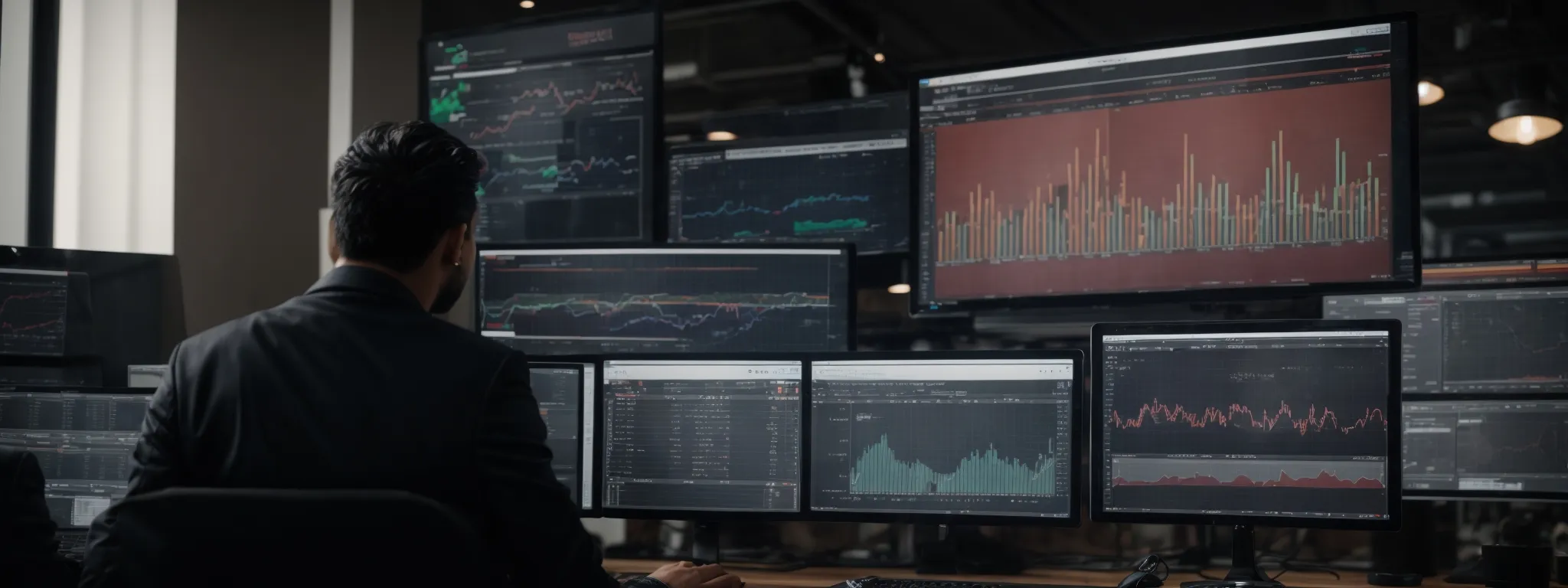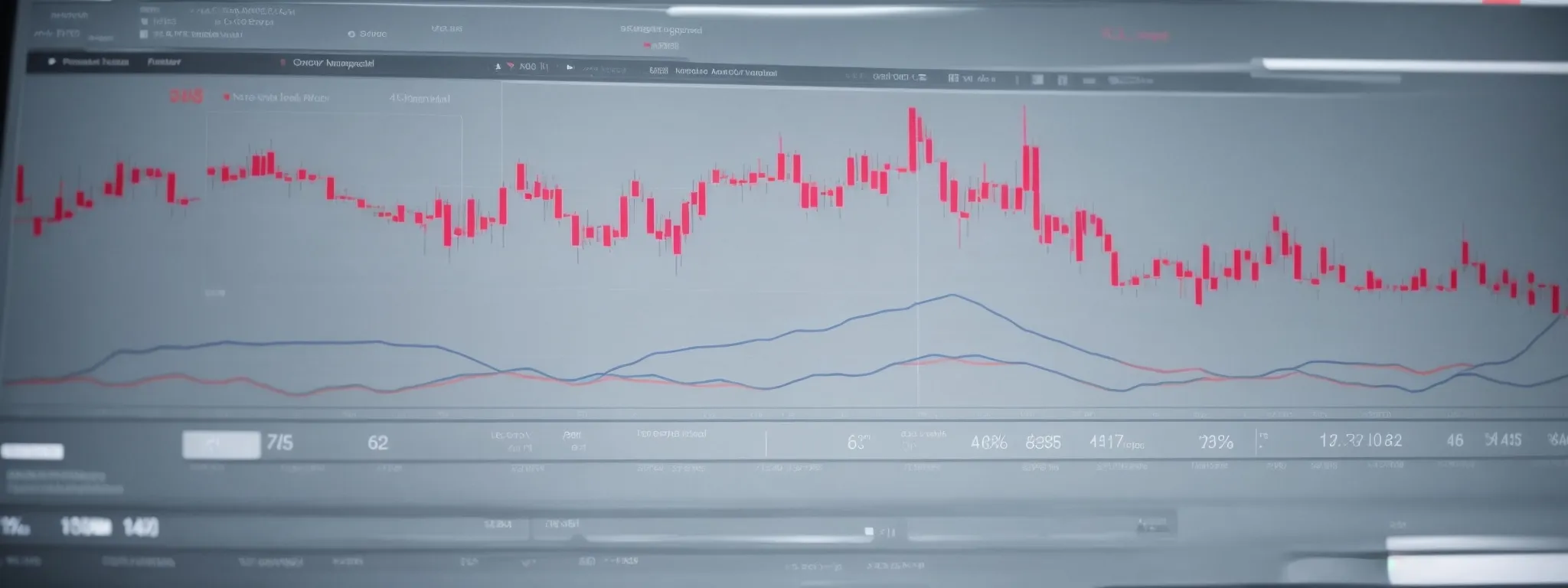Diagnosing Website Traffic Drops
Understanding and Diagnosing Website Traffic Declines When a company experiences an unexpected downturn in website traffic, it can feel akin to steering a ship amidst a silent […]
Understanding and Diagnosing Website Traffic Declines
When a company experiences an unexpected downturn in website traffic, it can feel akin to steering a ship amidst a silent storm.
The cause isn’t always clear, and the solution isn’t written in the skies.
Diagnosing the root of sudden declines involves a thorough examination of search engine algorithms, tracking set-ups, technical site issues, and external market shifts.
Expertise in pinpointing the precise factors at play is critical to navigating back to calmer, more lucrative waters.
Keep reading to uncover how businesses can adeptly identify the culprits of traffic downturns and execute a strategic recovery.
Key Takeaways
- LinkGraph’s SEO Services Prioritize Methodical Analysis Using Advanced Tools to Diagnose and Remediate Website Traffic Downturns
- Meticulous Tracking and Data Accuracy Through Tools Like SearchAtlas SEO Software Are Essential for Making Data-Driven Strategic Decisions in SEO
- Ongoing Vigilance in Adapting SEO Strategies to Algorithm Changes and SERP Feature Updates Is Crucial for Maintaining Search Visibility
- Comprehensive Competitor Analysis With SEO Tools Provides Insights That Inform Tactical Shifts and Improve Search Engine Rankings
- LinkGraph Advocates for Continuous Monitoring and Iterative Optimization, Utilizing Key Metrics and Essential SEO Tools for Sustained Traffic Recovery
Initial Steps to Diagnose Website Traffic Declines

Navigating the complexities of a downturn in website traffic begins with a methodical analysis, an approach often championed by Industry Leaders Such as LinkGraph.
The discerning business owner, armed with essential SEO tools and data, can initiate their investigation by immersing themselves in the nuances of their analytics dashboard.
This crucial step provides immediate, actionable insights and sets the stage for a thorough evaluation.
It’s essential to establish a precise timeframe that correlates with the onset of the traffic decline, as this will assist in pinpointing its origin.
By meticulously cross-referencing traffic patterns against recent amendments to their web pages, the astute content strategist can discern the impact of changes made.
Furthermore, a granular comparison of the influx of organic visitors versus those of paid campaigns yields a fuller understanding of the traffic trends.
Entwined in these preliminary actions is the implicit goal of revealing the underpinnings of traffic fluctuations, thereby enabling businesses and agencies, particularly those availing LinkGraph’s SEO services, to forge ahead with a revitalized strategy.
Reviewing Your Analytics Dashboard for Traffic Insights
Upon encountering a downturn in site traffic, immediate attention turns to the treasure trove of insights within the analytics dashboard. By Meticulously Employing the Tracking Code and analytics data, the astute LinkGraph team can swiftly attribute traffic shifts to specific updates or external events.
Dedicated analytics platforms, when layered with SearchAtlas SEO software, enhance visibility into user behavior, highlighting whether a sudden drop is due to algorithm changes, altered user preferences, or evolving market dynamics. Parsing through this labyrinth of data allows businesses to remain agile, recalibrating their online presence in alignment with performance metrics.
Setting a Timeframe for the Observed Traffic Drop
Identifying the exact interval when website traffic began to wane is pivotal in understanding both the magnitude and immediacy of the situation. LinkGraph’s SEO experts recommend marking this period as a reference point to analyze changes and to identify patterns that might not be apparent during peak performance times.
Acting with alacrity, the SEO team uses tools like SearchAtlas to isolate this timeframe within historical data, ensuring a meticulous assessment of traffic oscillations. This temporal anchoring serves as a foundation for a more pointed and effective investigation into the causes behind the decline in site visits.
Cross-Referencing Traffic Data With Website Changes
Upon recognizing a downturn in website visits, professionals like those at LinkGraph begin the process of cross-referencing the decrease with recent alterations to the site’s content or structure. This exercise reveals the congruence between modifications made and the subsequent shifts in user acquisition, enabling experts to gauge the efficacy of recent updates.
In critical circumstances where traffic attenuation aligns with website changes, a thorough audit performed using LinkGraph’s comprehensive ranking guide and SEO services can unravel the layers affecting search result standings. This approach allows for the dissection of each variably—be it a new page addition, a restructuring of a sitemap, or an implementation of a new script—to assess their individual impact on the site’s organic traffic flow.
Comparing Organic Versus Paid Traffic Trends
An in-depth analysis of the differential between organic and paid traffic provides key insights into the overall health of a website’s marketing strategy. LinkGraph leverages SearchAtlas SEO software to parse through these variances, charting a clear delineation that informs the recalibration of a client’s campaign focus, ensuring resources are optimally allocated.
Significant diligence in this comparison unearths patterns that speak volumes about user intent and the efficacy of search engine ranking strategies. The expertise of LinkGraph’s SEO services enables clients to discern the true drivers behind traffic fluctuations, empowering them to construct a robust, data-driven approach to bolster their digital presence.
The Impact of Search Engine Algorithm Updates

In the realm of digital marketing, search engine algorithm updates command significant influence over the fluctuation of website traffic, and comprehending these changes is paramount for the maintenance of a thriving online space.
As search engines refine their systems to improve user experiences, it is incumbent upon businesses to assess their organic traffic and adjust SEO strategies promptly.
LinkGraph’s SEO experts utilize an arsenal of cutting-edge tools and the adeptness inherent in SearchAtlas SEO software to identify recent updates poised to disrupt traffic flow.
This vigilance ensures a rapid and knowledgeable response to adapt to the evolving algorithm rules, securing a brand’s visibility and search ranking amidst the constant ebb and flow of the digital tide.
Identifying Recent Updates That Might Affect Traffic
In the dynamic landscape of search engine optimization, algorithm updates play a critical role in shaping website traffic trends. LinkGraph’s SEO services are proficient at pinpointing the timing and nature of these updates, ensuring that client websites remain in step with the latest search engine criteria and user search behaviors.
Clients Seeking to Understand Shifts in their digital footprints benefit from the comprehensive insights provided by LinkGraph, which include monitoring search algorithm changes and evaluating their impacts on search rankings. Through their expert analysis, businesses can fine-tune their SEO strategies, safeguarding their online prominence:
| SEO Consideration | Methodology | LinkGraph Solution |
|---|---|---|
| Algorithm Update Detection | Mapping out algorithm release dates to traffic patterns | SearchAtlas SEO software |
| Impact Assessment | Quantifying changes in search rankings and user engagement | Comprehensive ranking guide |
| Strategic Adjustment | Aligning SEO tactics with updated search engine algorithms | Customized SEO content strategy |
Tools and Resources for Tracking Algorithm Changes
To stay abreast of the frequent changes in search engine algorithms, LinkGraph appropriates sophisticated tools designed to detect even the subtlest modifications. Their SearchAtlas SEO software stands out as an exemplary resource, Providing Detailed Notifications and Insights that enable the anticipation and understanding of impacts on search rankings.
This preemptive strategy, armed with advanced predictive capabilities, permits business owners to implement timely adjustments to their SEO tactics. Rather than reacting to traffic dips post-factum, clients can rely on predictive alerts and tailored advice from LinkGraph’s SEO services to Maintain and Elevate Their Website’s Search Engine Standing.
Adjusting SEO Strategy to Adapt to New Algorithm Rules
Adapting an SEO Strategy to accommodate new algorithm rules is a critical step for maintaining and improving search engine visibility. LinkGraph’s adept team of SEO professionals helps businesses realign their online content and backlink strategies to meet the updated criteria, ensuring the sustained relevance and authority of their websites in the search engine landscape.
With the deployment of intelligent SEO AI writers and on-page SEO services, LinkGraph enables quick and effective modifications to a website’s content, enhancing its ability to resonate with both search engines and users. This pivot is not merely reactive but is a forward-thinking measure that supports the enduring growth and visibility of a client’s digital presence.
Missteps in Tracking Setup That Skew Data

Discovering a downturn in website traffic can often lead stakeholders to scrutinize their marketing strategies and SEO practices.
However, before embarking on an extensive overhaul, it is critical for businesses to ensure that the very data they rely on for decision-making is not compromised by tracking errors.
Properly implemented and finely tuned analytics tools are the backbone of any traffic analysis, yet they are not immune to configuration pitfalls that can obscure the true picture of website performance.
The forthcoming explorations dive into the essentials of traffic tracking accuracy, tackling the challenge of auditing tracking codes and rectifying reporting discrepancies.
It is within these technical nuances that companies, guided by LinkGraph’s expertise, can secure a dependable foundation to accurately assess and strategize against traffic variances.
Ensuring Accurate Traffic Tracking With Analytics Tools
Accuracy in traffic tracking forms the cornerstone of any robust analytics strategy, a notion the experts at LinkGraph fully understand. Integrating dependable analytics tools, such as Google Analytics, requires precise calibration to ensure data reflects actual user interactions, untainted by mishandled tags or tracking codes.
As businesses navigate their digital milieu, the importance of unerring data collection cannot be overstated. LinkGraph’s seasoned professionals perform meticulous validations that safeguard against the inadvertent omission of codes or distorted interpretations of traffic sources, thereby guaranteeing the integrity of the traffic data upon which strategic decisions hinge.
Auditing Your Tracking Codes for Potential Issues
A forensic approach to SEO necessitates a comprehensive audit of tracking codes, as discrepancies here can derail the most astute analysis. LinkGraph’s SEO services extend beyond mere observation, delving into code integrity to assure clients that the data they act upon is accurate and trustworthy.
Issues such as duplicative tracking scripts or improperly configured event tags on a site can cause significant data anomalies. LinkGraph thoroughly investigates these potential pitfalls, enabling the restoration of data veracity and the reassurance that subsequent strategic decisions are based on solid ground:
| Tracking Audit Focus | Common Issues | LinkGraph Solution |
|---|---|---|
| Code Integration | Duplicate tracking snippets | Precise code placement checks |
| Tag Configuration | Misconfigured event tags | Custom tag validation process |
| Data Reliability | Incorrect attribution of traffic source | In-depth source verification |
Rectifying Discrepancies in Traffic Reporting
Rectifying discrepancies in traffic reporting is an essential response to ensure the authenticity of data upon which strategic marketing decisions are made. The response involves a meticulous reexamination and adjustment of tracking codes to remedy any distortion in analytics. LinkGraph’s SEO services, through a thorough investigation of traffic reporting systems, seek to restore accuracy and provide clients with reliable metrics for their websites.
After identifying the root cause of data discrepancies, LinkGraph’s team of professionals embarks on implementing the necessary corrections:
- They systematically review and correct tracking code errors or anomalies.
- They recalibrate analytics settings to capture traffic data precisely and reliably.
- Finally, they ensure continuous monitoring for consistent tracking functionality.
With LinkGraph’s expertise in dealing with such intricacies, clients can confidently navigate through the ebbs and flows of digital marketing, backed by a foundation of veritable and actionable traffic insights.
Common Technical Issues Leading to Traffic Loss

Within the intricate web of factors contributing to declines in website traffic, technical detriments often lurk unnoticed, manifesting as substantial impediments to site accessibility and indexation.
Pinpointing these technical roadblocks constitutes a vital aspect of remediation, ensuring that a business’s digital infrastructure is fully optimized for both search engines and users.
Impeccable site health is a priority for firms such as LinkGraph, whose meticulous approach encompasses the identification and resolution of crawl issues, alongside the critical assessment of robots.txt files for any impediments.
Equally, they recognize the necessity of scrutinizing a site for broken links and inefficient redirects, recognizing that these seemingly minor hitches can culminate in significant traffic loss.
Spotting and Resolving Crawl Issues on Your Website
Search engines navigate websites by crawling, and any impediment to this process can result in a notable drop in site traffic. LinkGraph’s SEO professionals emphasize the necessity of regularly auditing websites to detect and resolve any crawl issues promptly, ensuring that all content is accessible and indexable, thus safeguarding search engine visibility.
Addressing critical server errors or misconfigured redirect loops plays a substantial role in maintaining robust website health. Utilizing SearchAtlas SEO software, LinkGraph adeptly identifies technical inconsistencies that disrupt search engine crawlers, providing swift, targeted interventions to restore and optimize the pathways through which search engines interact with website content.
Inspecting for Incorrect Use of robots.txt File
An often-overlooked aspect of website management is the proper configuration of the robots.txt file, a crucial element that commands which parts of a site search engines can crawl and index. The team at LinkGraph regularly conducts thorough inspections of this file to ensure that no valuable content is inadvertently blocked from search engine view, thus preventing unnecessary impediments to website traffic.
Correcting erroneous directives within the robots.txt file can significantly influence a website’s ability to rank in search results. LinkGraph’s meticulous approach involves a careful review of its syntax and rules to eliminate any disallow commands that may mistakenly exclude important pages from being discovered and, consequently, from appearing in the search engine results pages (SERPs).
Checking for Broken Links and Redirects on Your Site
A website riddled with broken links or ineffective redirects can severely undermine user experience and damage search engine rankings. LinkGraph’s meticulous SEO services include a Rigorous Examination of Link Integrity and redirect practices, ensuring that every link functions optimally and guides users and search engine crawlers to the intended destination seamlessly.
By proactively detecting and repairing these issues, LinkGraph ensures that website visitors encounter no barriers to information or navigation, which could otherwise escalate into a downturn in site traffic. Their attention to detail in this regard fortifies the navigational structure of a client’s website, solidifying the foundation upon which digital visitor engagement is built.
Troubleshooting Indexing Issues and De-Indexed URLs

In the labyrinthine journey of digital marketing, professionals encounter a myriad of challenges that stymie the consistent flow of awareness to their offerings.
Among these intricacies, the vexing issue of URLs slipping from the search engine’s radar—a phenomenon that precipitates declines in website traffic—stands out.
Addressing such indexing aberrations is crucial; experts underscore the utilitarian prowess of tools like Google’s Search Console for monitoring indexing status.
The acumen to swiftly resolve accidental uses of noindex tags or canonical errors is indispensable, as is the dexterity involved in reindexing pages integral to a site’s traffic countenance.
These collective efforts coalesce to recapture and reinforce a website’s visibility in the digital domain.
Using Search Console to Check Indexing Status
LinkGraph’s seasoned professionals recognize the potency of Google’s Search Console as a pivotal resource for diagnosing indexing anomalies. The Console’s versatile features enable users to swiftly ascertain the index status of individual URLs, a critical measure when investigating unexplained traffic dips.
In these critical examinations, Search Console serves as a navigational beacon, guiding the optimization process by flagging de-indexed pages and providing essential insights. This function proves invaluable for LinkGraph’s SEO experts as they work to rectify indexation issues and restore a website’s visibility within the search landscape.
Resolving Accidental Noindex Tags and Canonical Errors
When accidental noindex tags make their unwelcome appearance, they become silent saboteurs of a website’s traffic by telling search engines to overlook crucial pages. LinkGraph’s SEO specialists channel their focus toward the detection and correction of these tags, ensuring that each page intended for indexing is visible and contributory to the site’s online footprint.
Canonical errors, another common glitch, can dilute the importance of content across multiple URLs, confusing search engines and diminishing a webpage’s search visibility. The experts at LinkGraph delve into the intricacies of canonicalization, resolving ambiguities to establish clear directions for search engines to follow, thereby streamlining the path to robust search rankings and consistent website traffic.
Reindexing Important Pages That Have Been Lost
Essential pages that have been lost from a search engine’s index require decisive actions for reindexing to recover the website’s visibility and traffic levels. LinkGraph’s professionals provide strategic solutions aimed at swift reindexing, thus assuring that every important page contributes positively to the website’s search result performance.
Upon detecting pages that have vanished from the index, the poignant task is to guide search engines back to these URLs for re-examination and reinsertion into their database:
- LinkGraph initiates by submitting an updated sitemap through Search Console, pinpointing the lost pages for search engines.
- They then leverage the URL Inspection tool to request immediate re-crawling and reindexing of the specific pages.
- Lastly, any identified underlying issues are resolved to prevent future deindexing, sustaining the site’s comprehensive visibility.
Analyzing Competitor Movements and Ranking Changes

In the dynamic theater of online visibility, a decline in website traffic often prompts business owners to cast a discerning eye on their competitive landscape.
Vigilant in their pursuit of sustained digital dominance, these proprietors understand the benefit of benchmarking their site against key industry players.
This systematic comparison reveals invaluable insights, informing targeted adjustments to SEO strategies.
A firm grasp on the reasons behind ranking shifts enables a company, such as those availing themselves of LinkGraph’s SEO services, to adapt proficiently in an ever-changing market.
The ensuing discourse elucidates the nuanced tactics for analyzing competitor movements and the subsequent recalibration of SEO methodologies to preserve and enhance search engine standing.
Benchmarking Your Site Against Key Competitors
In the competitive analysis of digital landscapes, benchmarking stands as a cardinal practice. Enterprises utilizing LinkGraph’s SEO services undertake meticulous comparisons between their site and those of leading competitors, sharpening their competitive edge.
This strategic evaluation hinges on a wealth of metrics, including keyword rankings, backlink profiles, and content quality:
| Competitive Metric | SEO Analysis Focus | LinkGraph Tool Utilized |
|---|---|---|
| Keyword Rankings | Analyzing positioning for key search terms | SearchAtlas SEO software |
| Backlink Profiles | Assessing authority and relevance of inbound links | Free backlink analysis |
| Content Quality | Evaluating readability and topic coverage | SEO AI writer |
By systematically dissecting competitive standing, businesses foster informed improvements and tactical shifts that consolidate their position within the search engine rankings.
Adjusting SEO Strategy in Response to Competitor Analysis
An adept reconfiguration of SEO strategy, informed by competitor analysis, enables enterprises to edge ahead in the search engine rankings. LinkGraph’s SEO services are pivotal in this recalibration, offering a nuanced understanding of the competitive landscape that drives strategic SEO alignment.
LinkGraph’s savvy exploitation of market insights ensures their client’s SEO tactics are not only responsive but also proactive, anticipating competitor moves to optimize search visibility. This strategic foresight is embraced by those keen on sustaining a dominant online presence despite market volatility.
Understanding the Reasons Behind Ranking Shifts
Grasping the catalysts behind shifts in search rankings necessitates a thorough examination of the ever-evolving algorithms of search engines alongside the competitive practices within an industry. LinkGraph’s SEO services engage in continuous monitoring and analysis, recognizing that shifts can stem from a cornucopia of factors, including search engine algorithm adjustments, modifications by competitors, or even changes in user search behavior and intent.
LinkGraph’s experienced SEO professionals leverage their adept analysis to unearth the root causes of a client’s fluctuating search engine positions. This keen insight empowers businesses to fine-tune their SEO efforts, ensuring they respond effectively to changes in the digital landscape to maintain and enhance their online visibility and authority.
Dealing With Google Manual Actions and Penalties

Website traffic declines can often leave stakeholders perplexed, prompting an urgent need to uncover the root cause.
Among the array of potential culprits, Google Manual Actions stand out as a critical factor capable of significantly impacting a site’s search visibility.
Identifying these manual penalties necessitates a strategic approach starting with a review of notifications within Google Search Console, which serves as a diagnostic hub.
Once pinpointed, decisive steps must be taken to resolve the issues that triggered the penalty, leading to a formal review submission.
After alleviating the imposed restrictions, monitoring traffic recovery is paramount to evaluate the effectiveness of the remediation and to recalibrate future SEO practices accordingly.
This section ventures into exploring the meticulous processes entwined in the reconciliation of Google Manual Actions and the path to restoring a website’s stature within search engine rankings.
Identifying Manual Penalties in Google Search Console
To swiftly Pinpoint Manual Penalties, diligent scrutiny of Google Search Console is vital. This tool is indispensable for webmasters and SEO experts alike, as it alerts users to penalizations issued by Google that could dampen search visibility.
Once inside the Search Console, the notification center provides detailed reports on manual actions, informing business owners and digital marketers about specific violations and areas requiring immediate attention:
- Navigate to the “Security & Manual Actions” section.
- Click on “Manual Actions” to view any extant penalties.
- Assess the listed issues and understand the reasons behind each action.
The identification of these actions enables the team from LinkGraph to take corrective measures. The goal is not only to appease the search engine’s guidelines but also to fortify the site’s overall SEO integrity.
Steps to Resolve Issues and Submit for Review
Upon the identification of manual penalties in Google Search Console, LinkGraph’s SEO services swiftly mobilize to amend the infractions that triggered the action. This remediation process involves careful revision of website content, a reassessment of backlink profiles, and alterations to meta tags to align with Google’s guidelines. The diligent correction of these issues is a prerequisite for seeking reinstatement in search rankings.
Following the resolution of these issues, the next step is a meticulous submission for review via Google Search Console, where LinkGraph articulates the changes implemented and petitions for the revocation of any penalties. This submission prompts a reassessment by Google, a critical juncture which, if successful, reinstates the website’s standing in search engine results, potentially restoring traffic to its prior volume.
Monitoring Traffic Recovery Post Resolution
Once the necessary modifications have been implemented and Google has lifted any manual actions, it is imperative for businesses to closely watch the recovery of their website traffic. LinkGraph, utilizing its advanced array of SEO tools and strategies, meticulously measures the resurgence of user visits and engagement to ensure the corrective actions have yielded the desired effect on search visibility and organic search performance.
LinkGraph’s experts vigilantly monitor various metrics post-resolution, including search ranking improvements and user behavior changes, to confirm the trajectory toward full traffic recovery. This observation period is crucial in evaluating the effectiveness of the remedial efforts and provides data-driven insights for future SEO strategies to prevent similar declines.
Potential Causes for a Sudden Drop in Keyword Rankings

Website traffic, pivotal to the success of any digital venture, hinges largely on the visibility and positioning of a website within search engine result pages (SERPs).
A sudden drop in keyword rankings can sound alarm bells for business owners and SEO strategists alike, prompting immediate investigation into this troubling occurrence.
Armed with a keen understanding of search engine metrics and behaviors, LinkGraph’s SEO experts examine declines in SERP positions for primary keywords, delving into the nuances of keyword cannibalization and evaluating the sufficiency of on-page optimization and content quality.
Each of these factors plays an integral role in determining a website’s prominence in the digital landscape, and rectifying issues in these areas can dramatically enhance a site’s traffic trajectory.
Investigating Drops in SERP for Primary Keywords
When primary keywords lose traction in search engine results pages (SERPs), the investigation requires precision and a strategic perspective. LinkGraph’s SEO services intently focus on historical data and current SEO practices to detect potential misalignments in keyword targeting and usage that could be responsible for the downshift in rankings.
The dedicated SEO team at LinkGraph considers a variety of factors, including recent website changes, backlink stability, and competitor keyword performance, as they could all intricately influence SERP standings:
| SEO Factor | Potential Influence on SERP |
|---|---|
| Website Updates | Improperly implemented changes or content updates may dilute keyword relevance or disrupt user experience. |
| Backlink Profile | A loss or devaluation of quality backlinks can diminish domain authority and SERP positioning. |
| Competitive Keyword Dynamics | Shifts in competitors’ keyword strategies might outperform current optimizations, leading to ranking declines. |
Assessing the Impact of Keyword Cannibalization
When keyword cannibalization takes place, it confounds search engines and dilutes the efficacy of a website’s SEO strategy. LinkGraph’s team of SEO analysts can determine if multiple pages competing for the same queries are undermining a site’s ability to rank effectively.
LinkGraph’s comprehensive analysis extends to discerning the extent of cannibalization’s impact, meticulously evaluating whether it contributes to fluctuations in keyword performance. This rigorous assessment informs the re-optimization of content, aligning it more strategically with search intent to bolster keyword rankings.
Improving on-Page Optimization and Content Quality
In the quest to elevate a site within search engine result pages, honing on-page optimization and content quality is crucial. LinkGraph’s team of SEO professionals endorses a strategic approach that scrutinizes and enhances meta tags, ensures keywords are strategically integrated, and confirms that internal linking structures guide both users and search engines efficaciously.
Ensuring content resonates with both search engine criteria and user intent involves a thorough analysis and refinement of existing web pages. The experts at LinkGraph employ readability tools alongside SEO AI writers to craft content that strikes a balance between informative and SEO-friendly while echoing the brand’s tone and audience’s needs.
- Examination and optimization of title tags, meta descriptions, and headers to improve relevance and click-through rates.
- Strategic placement and density of keywords to align with user search intent and maintain content readability.
- Streamlining internal link architecture to distribute page authority and facilitate user navigation.
- Employment of multimedia elements such as images and videos with properly tagged alt attributes to enhance user engagement.
Effects of SERP Layout and Feature Changes

As the digital landscape evolves, so do the search engine results pages (SERPs), with frequent modifications in layout and the introduction of novel features known to affect website traffic.
These changes can significantly alter user interaction and click-through rates, compelling businesses to closely monitor and adapt to Google’s nuanced result page templates.
Mastery of this dynamic environment requires adjusting SEO tactics to harness opportunities presented by emerging SERP elements, such as featured snippets and rich results, to maintain a competitive edge and maximize online visibility.
Keeping Up With Changes in Google’s Result Page Design
Businesses must remain vigilant in the face of evolving SERP layouts and features, as these changes can tip the scales of online visibility. LinkGraph’s adept SEO services extend to closely tracking and understanding the nuances of Google’s result page design, ensuring clients’ strategies remain aligned with the latest developments.
Adapting to SERP transformations is a continuous effort that necessitates a proactive approach to SEO management:
- Assessing the potential impact of new SERP features on click-through rates.
- Refining content and on-page elements to capitalize on rich snippets and answer boxes.
- Ensuring clients’ sites are optimized for maximum visibility within the changing digital landscape.
This agility ensures that websites maintain a competitive position, leveraging the opportunities surfacing with each Google update to their advantage.
Adapting to New SERP Features Impacting Click-Through Rates
In response to the latest SERP innovations, businesses often find the need to alter their approach to ensure that burgeoning features like People Also Ask boxes and local pack listings do not undercut their click-through rates. LinkGraph’s SEO experts guide their clients through these transitions, optimizing content to harmonize with emergent elements that have the power to redirect or distribute user attention.
LinkGraph’s team skillfully navigates these alterations, ensuring that client websites are refined to make the most of enhanced listings, whether through structured data optimization or by crafting content that directly answers common queries. Such adaptability is vital as it helps maintain a strong online presence, even as the digital terrain shifts around them.
Modifying Content to Target Featured Snippets and Rich Results
LinkGraph’s strategic approach to content modification ensures that their clients’ websites are primed for the coveted featured snippets and rich results in SERP layouts. Their experienced SEO experts adeptly revise content, concentrating on clarity and the inclusion of succinct, answer-focused snippets that meet the searchers’ immediate needs, vastly increasing the potential for enhanced visibility.
Through a meticulous evaluation of existing content, LinkGraph identifies opportunities to optimize for rich results, ensuring client websites are marked up correctly and structured in a way that search engines can easily parse and present information as featured snippets. This targeted content strategy positions the information in a way that not only serves user intent but also aligns seamlessly with Google’s evolving algorithms for SERP features.
Systematic Approach to Recover Lost Website Traffic

In the face of dwindling website traffic, a structured response is paramount for restoration.
Businesses must adopt a systematic approach, commencing with the prioritization of issues that meld the gravity of their impact with the feasibility of their resolution.
Tackling technical SEO dilemmas head-on, LinkGraph’s SEO services emphasize on executing precise fixes that are conducive to revitalizing website performance.
The process of recovery is sustained by diligent monitoring and iterative optimization, ensuring a steady recalibration of strategies that adapt to search engine benchmarks and user expectations.
This introductory overview sets the stage for a detailed exploration of strategic recovery measures designed to reclaim and enhance website traffic.
Prioritizing Issues Based on Impact and Ease of Resolution
In the quest to recover lost website traffic, discerning which issues to address first is integral to an efficient resolution strategy. LinkGraph recommends that their clients prioritize challenges based on the potential impact on traffic and the practicality of implementing solutions. This targeted focus ensures immediate attention to high-impact areas that can be swiftly remedied, setting the stage for a faster recovery of traffic metrics.
LinkGraph’s SEO experts advocate for a strategic assessment that distinguishes critical issues from less consequential ones, allowing for a resource-savvy approach to problem-solving. By first rectifying issues that can bring about substantial improvements to traffic with relatively minimal effort, businesses can expedite the process of regaining their digital foothold and re-establishing their online presence efficiently.
Implementing Fixes for Technical SEO Problems
Addressing technical SEO challenges is a formidable undertaking that necessitates expertise and precision. LinkGraph’s SEO services skillfully deploy diagnostics to identify underlying issues, from server instability to faulty redirections, that hamper a website’s ability to communicate effectively with search engine crawlers.
Once technical hindrances are uncovered, LinkGraph’s seasoned professionals take the initiative, implementing targeted remedies that prevent these deficiencies from stifling a website’s traffic inflow. Their actions range from refining robots.txt files to optimizing XML sitemaps, ensuring search engines can seamlessly navigate and index the site’s content.
Monitoring Progress and Iterative Optimization for Recovery
In the aftermath of implementing fixes for technical SEO challenges, a vigilant eye on the progression of traffic metrics is critical. LinkGraph’s SEO services ensure that progress is monitored through a suite of essential SEO tools, tracking the effectiveness of each implemented change and the resulting impact on website traffic.
This continuous scrutiny is underpinned by LinkGraph’s belief in iterative optimization: a relentless pursuit of refinement where SEO strategies are not static but dynamic, regularly adjusted based on real-time data and emerging trends. Their commitment to adapting SEO practices fits within an ever-shifting search landscape, ensuring that recovery is not just a goal, but a sustained success.
Conclusion
Understanding and diagnosing website traffic declines is essential for maintaining a successful online presence.
By taking a systematic approach to analyze traffic patterns, using tools like SearchAtlas and Google Search Console, businesses can pinpoint the underlying causes of traffic drops.
It’s critical to prioritize issues based on their impact and the ease of resolution to efficiently restore traffic levels.
Technical SEO problems must be addressed with precision, and issues such as improper use of noindex tags or faulty redirects need prompt rectification.
Additionally, adapting to algorithm updates and SERP feature changes is crucial for staying competitive.
Monitoring progress and engaging in iterative optimization ensures strategies remain effective in an ever-changing digital landscape.
LinkGraph’s expertise highlights the importance of being proactive and informed in order to recover and enhance website traffic, securing the site’s long-term search visibility.














































































